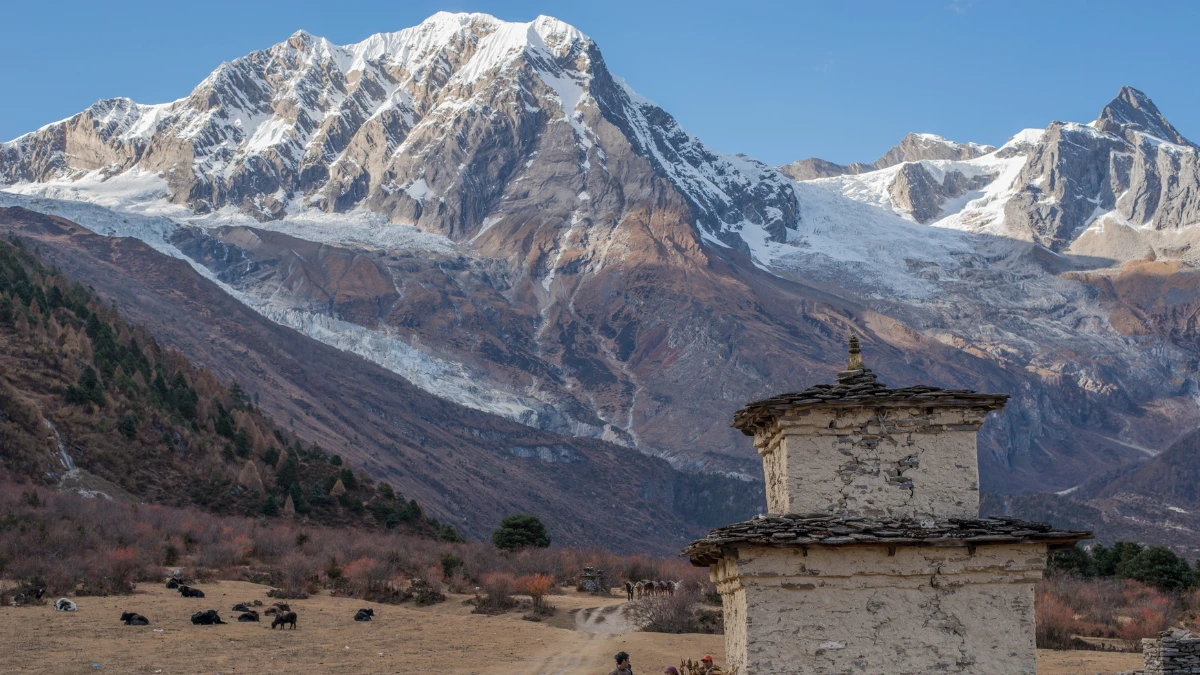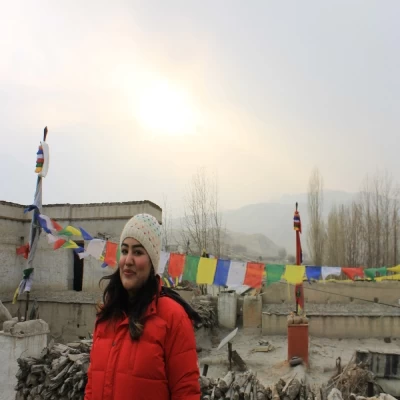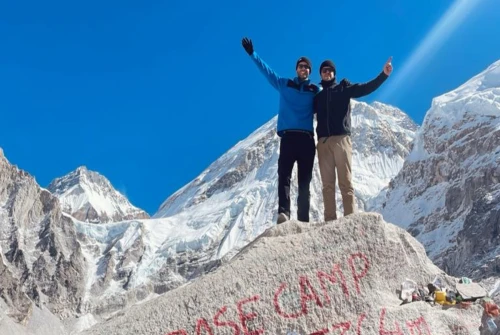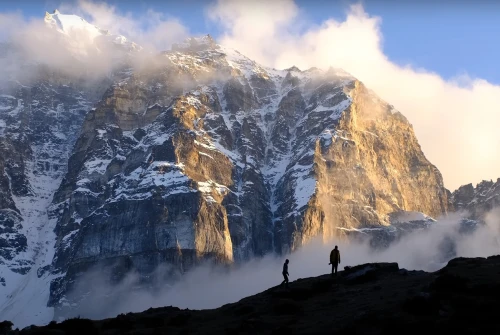Detailed Overview of the Manaslu Circuit Trek
The Manaslu Circuit Trekis one of Nepal’s most fascinating and off-beat trekking routes, circling the majestic Mount Manaslu (8,163m), the eighth-highest mountain in the world. The trek beautifully combines Himalayan scenery, rich Tibetan-influenced culture, and diverse climatic zones that change dramatically as you ascend. Starting from the lush subtropical valleys of Soti Khola, the trail winds through alpine meadows, glacial valleys, and high mountain passes before concluding at Dharapani.
Unlike the crowded Annapurna and Everest regions, the Manaslu trek offers a more peaceful and authentic experience. However, due to its high altitude and varied terrain, understanding the monthly weather and temperature is crucial to planning your journey safely and comfortably.
The region experiences four major seasons: Spring, Monsoon, Autumn, and Winter, each offering a unique trekking experience. From blooming rhododendrons in spring to crystal-clear mountain views in autumn, every season has its own charm and challenges. Let’s dive into the detailed monthly weather, temperature, and rainfall patterns to help you choose the best time for your adventure.
Is the Manaslu Circuit Trek Safe?
Yes, the Manaslu Circuit Trek is generally safe, provided you trek during the favorable seasons, prepare well, and follow the guidance of licensed guides. Since it’s a restricted area trek, a minimum of two trekkers accompanied by a certified guide is mandatory.
The trail itself is well-established, but certain sections, particularly near Larke La Pass (5,160m), can be challenging due to snow or high winds during winter and early spring. The monsoon months (June–August) bring landslides and slippery trails, making this period riskier.
Altitude sickness is another potential concern since trekkers reach elevations above 5,000 meters. However, with proper acclimatization and gradual ascent, most trekkers complete the journey safely. Hiring an experienced guide, carrying essential medicines, and monitoring your health at higher altitudes are key safety measures.
Overall, with the right timing and preparation, the Manaslu Circuit Trek is one of Nepal’s safest and most rewarding treks, offering an unforgettable combination of nature, culture, and adventure.
Seasonal Weather Patterns and Their Impact on Manaslu Circuit Trekking
Understanding the weather is vital when trekking in the Himalayas. The Manaslu region’s climate ranges from subtropical at lower altitudes to alpine and arctic at higher elevations. Here’s a breakdown of each trekking season and how it impacts your experience.
Spring (March–May): The Blooming Season for Manaslu Circuit Trek
Spring is considered one of the best times to trek the Manaslu Circuit. As winter fades, the trails come alive with rhododendrons, orchids, and magnolias in full bloom, painting the forests in shades of red, pink, and white.
Temperature:
- Lower region (700m–2,000m): 10°C–25°C
- Higher region (3,000m–5,160m): -5°C–15°C
Weather: Clear mornings and mild afternoons with occasional light rain in May.
Highlights: Stunning views of Mount Manaslu, Ganesh Himal, and Himalchuli.
Days are pleasantly warm, and nights are cool but manageable. It’s also the peak climbing season, meaning you’ll encounter other trekkers and mountaineers. With stable weather and good visibility, spring offers the perfect blend of comfort and scenery.
Monsoon (June–August): The Wet and Challenging Season
The monsoon season brings heavy rainfall, making this period less favorable for trekking the Manaslu Circuit. The lower trails become muddy and slippery, and frequent landslides can obstruct paths. However, for those seeking solitude, this is when the region is at its greenest and quietest.
Temperature:
- Lower region: 20°C–30°C
- Higher region: 5°C–15°C
Rainfall: 500–700 mm (maximum during July and August)
Challenges: Leeches, landslides, and cloud-covered mountains.
Although the views are limited due to mist and clouds, post-rain mornings can occasionally reveal breathtaking, crystal-clear scenery. If you decide to trek during this season, pack waterproof gear, sturdy boots, and insect repellent.
For safety reasons, most trekkers avoid Manaslu during the monsoon and choose to trek right after it ends, in early September.
Autumn (September–November): The Prime Trekking Season
Autumn is undoubtedly the best time for the Manaslu Circuit Trek. The monsoon rains leave the air fresh and the landscapes dust-free, offering spectacular visibility of the mountains. The trails are vibrant with festivals like Dashain and Tihar, adding cultural richness to your journey.
Temperature:
- Lower region: 8°C–20°C
- Higher region: -2°C–12°C
Weather: Stable, dry, and clear skies with minimal precipitation.
Highlights: Perfect conditions for photography and high pass crossings.
During this period, you can expect consistent weather, comfortable days, and clear nights, ideal for crossing the Larke La Pass. Tea houses are open, and the trekking community is lively but not overly crowded like the Everest or Annapurna routes. If you seek the perfect combination of comfort, visibility, and safety, autumn is the time to go.
Winter (December–February): The Cold and Serene Season
Winter transforms Manaslu into a snow-clad wonderland. While the lower regions remain accessible, the upper trails, especially near Larke La Pass, experience heavy snowfall, making them difficult to cross.
Temperature:
- Lower region: 0°C–12°C
- Higher region: -10°C to -20°C
Weather: Crisp, clear skies with occasional snowstorms.
Highlights: Fewer trekkers, peaceful lodges, and stunning snowy landscapes.
Only experienced trekkers attempt the circuit during winter. With proper cold-weather gear and guides familiar with the route, trekking is possible up to Samagaun or Samdo, where the views are equally spectacular. Winter treks are rewarding for those who love solitude, but be prepared for freezing nights and potential trail closures beyond 4,500 meters.
Summary: Choosing the Right Time to Trek
Season | Months | Temperature (°C) | Rainfall (mm) | Trekking Difficulty | Visibility | Best For |
Spring | Mar–May | -5 to 25 | 50–150 | Moderate | Excellent | Flowers & Clear Views |
Monsoon | Jun–Aug | 5 to 30 | 500–700 | High | Low | Green Landscapes |
Autumn | Sep–Nov | -2 to 20 | 50–100 | Easy–Moderate | Excellent | Photography & Festivals |
Winter | Dec–Feb | -20 to 12 | 20–60 | High | Good | Snow Views & Solitude |
Verdict:
The best time for the Manaslu Circuit Trek is Spring (March–May) and Autumn (September–November), offering the most stable weather, vibrant scenery, and safe conditions for crossing high passes.
Manaslu Circuit Trek Temperature Overview
The temperature on the Manaslu Circuit varies greatly depending on the altitude. Lower regions like Soti Khola and Jagat have warm subtropical climates, while higher areas such as Samagaun and Larke La can be extremely cold.
Altitude | Daytime Temperature (°C) | Night Temperature (°C) | Remarks |
700m–2,000m (Soti Khola–Jagat) | 15–30 | 8–15 | Warm and humid |
2,000m–3,500m (Namrung–Lho) | 10–20 | 0–10 | Cool and comfortable |
3,500m–5,160m (Samagaun–Larke La) | -5–10 | -10–-20 | Cold and windy |
Understanding these variations helps trekkers pack efficiently and layer properly, especially when transitioning from humid forests to icy mountain passes.
Manaslu Circuit Trek vs Annapurna Base Camp vs Everest Base Camp Trek
When planning your adventure in Nepal, you might find yourself comparing three of the most iconic Himalayan routes — Manaslu Circuit Trek, Annapurna Base Camp Trek (ABC), and Everest Base Camp Trek (EBC). While all three offer jaw-dropping mountain vistas and cultural immersion, each trek delivers a unique experience in terms of weather, crowd level, difficulty, and scenery.
1. Scenery and Landscape
Manaslu Circuit Trek: Offers a blend of remote wilderness and Tibetan-influenced culture. The route circles Mount Manaslu (8,163m) and passes through deep gorges, terraced fields, and high alpine passes. The scenery changes dramatically every few days, from lush subtropical forests to icy mountain deserts.
Annapurna Base Camp Trek: Known for its diverse ecosystem, ABC features terraced farmlands, bamboo forests, and the iconic Annapurna Sanctuary, surrounded by towering peaks like Machapuchare and Annapurna I.
Everest Base Camp Trek: Offers panoramic views of the world’s highest peaks, Everest, Lhotse, and Nuptse. The trail includes Sherpa villages, monasteries, and the famous viewpoint of Kala Patthar (5,545m).
2. Difficulty Level
Manaslu Circuit: Moderate to strenuous. The Larke La Pass (5,160m) poses the toughest challenge due to its steep ascent and unpredictable weather.
Annapurna Base Camp: Moderate. The trails are well-maintained, and altitude sickness is less of a concern.
Everest Base Camp: Moderately difficult. High altitude and long trekking days make acclimatization crucial.
3. Weather and Best Time to Trek
All three treks share similar ideal seasons, Spring (March–May) and Autumn (September–November).
However, the Manaslu Circuit is less crowded during these times, offering a more peaceful experience compared to the bustling ABC and EBC trails.
4. Crowd Level
Manaslu Circuit Trek: Restricted area permit limits the number of trekkers — making it perfect for solitude seekers.
Annapurna Base Camp: Popular among first-time trekkers and moderately crowded during peak seasons.
Everest Base Camp: The most popular trekking route in Nepal, often crowded, especially during October and April.
5. Cost Comparison
Trek Name | Average Duration | Permit Cost (USD) | Average Total Cost (USD) | Crowd Level |
Manaslu Circuit Trek | 14–18 Days | 100–150 | 1,200–1,800 | Low |
Annapurna Base Camp Trek | 7–10 Days | 50 | 800–1,200 | Moderate |
Everest Base Camp Trek | 12–14 Days | 50 | 1,500–2,000 | High |
Verdict:
If you’re seeking a remote, culturally rich, and scenic adventure, the Manaslu Circuit Trek is the perfect choice. It combines the raw beauty of Everest with the comfort of Annapurna — minus the crowd.
Manaslu Circuit Trek Monthly Rainfall Guide
Rainfall in the Manaslu region varies greatly throughout the year, influencing trail conditions, visibility, and accessibility. Below is a month-by-month rainfall breakdown to help you plan your trek wisely.
Month | Average Rainfall (mm) | Weather Highlights | Recommendation |
January | 25 | Cold, dry, with light snow in upper regions | Possible for experienced trekkers |
February | 30 | Cold mornings, stable skies | Good visibility |
March | 60 | Start of spring, mild weather | Excellent time to start trekking |
April | 90 | Blooming season, occasional showers | Perfect for photography |
May | 120 | Warmer, pre-monsoon rains begin | Manageable but humid |
June | 300 | Start of monsoon | Not recommended |
July | 500 | Peak rainfall, leeches common | Avoid trekking |
August | 450 | Rain gradually subsides | Trek possible end of August |
September | 150 | Fresh air after the monsoon | One of the best months to trek |
October | 80 | Crystal clear skies, perfect weather | Ideal for trekking |
November | 40 | Cool and dry | Great for late-autumn treks |
December | 30 | Cold and snowy at high altitudes | Possible till mid-December |
Summary:
The lowest rainfall months (October–November and March–April) offer the best trekking experience with clear skies and stable weather. Monsoon (June–August) should be avoided unless you’re an expert trekker equipped for muddy trails.
Comprehensive Packing Guide for Manaslu Circuit Trek
Packing properly for the Manaslu Circuit Trek can make or break your experience. Since you’ll pass through multiple climate zones — from tropical jungles to icy passes — it’s important to layer your clothing and carry essential gear for all conditions.
1. Clothing Essentials
- Base Layers: Moisture-wicking T-shirts and thermal tops.
- Mid Layers: Fleece jackets or down sweaters for warmth.
- Outer Layers: Waterproof and windproof jackets and trousers.
- Trekking Pants: Convertible and quick-dry types.
- Gloves, Beanies, and Buffs: For cold mornings and high passes.
2. Footwear and Accessories
- Trekking Boots: Waterproof, ankle-supporting boots are a must.
- Sandals or Camp Shoes: For resting after long trekking days.
- Woolen and synthetic socks: Carry multiple pairs to prevent blisters.
3. Trekking Gear
- Backpack (40–60L) with rain cover
- Sleeping bag (rated to -10°C or lower)
- Trekking poles for steep sections
- Headlamp with extra batteries
- Water bottles and purification tablets
4. Personal and Health Essentials
- Sunscreen (SPF 50+), sunglasses, and lip balm
- Personal first-aid kit (include Diamox, paracetamol, band-aids)
- Wet wipes, hand sanitizer, and toiletries
- Power bank or solar charger for electronics
5. Travel Documents and Permits
- Manaslu Restricted Area Permit (RAP)
- Manaslu Conservation Area Permit (MCAP)
- Annapurna Conservation Area Permit (ACAP)
- Valid Trekking Insurance (mandatory for high-altitude rescue)
Pro Tip:
Pack light but smart. Keep your total weight under 10–12 kg and use packing cubes or dry bags to organize gear and protect items from moisture.
Frequently Asked Questions (FAQs)
1. What is the best month to do the Manaslu Circuit Trek?
The best months are March–May (Spring) and September–November (Autumn). These periods provide the most stable weather, crystal-clear mountain views, and comfortable temperatures for crossing the Larke La Pass (5,160m).
2. Do I need a guide for the Manaslu Circuit Trek?
Yes, a licensed trekking guide is mandatory since the Manaslu region is a restricted area. Solo trekking is not allowed, and at least two trekkers are required per permit. A professional guide not only ensures safety but also enriches your understanding of both culture and geography.
3. How difficult is the Manaslu Circuit Trek?
The trek is classified as moderate to challenging, depending on your fitness level and preparation. The trails include steep ascents, rocky paths, and a high-altitude pass above 5,000m. However, with proper acclimatization, physical preparation, and pacing, most trekkers can complete it safely.
4. What is the highest point of the trek?
The Larke La Pass (5,160m) is the highest point of the Manaslu Circuit Trek. It offers breathtaking 360° views of snow-capped peaks, including Himlung Himal, Cheo Himal, Annapurna II, and of course, Mount Manaslu (8,163m).
5. Is there Wi-Fi and electricity on the trek?
Yes, most tea houses along the trail provide solar or hydro-powered electricity for charging electronics. Wi-Fi is available in villages like Samagaun, Namrung, and Lho, but expect slow connections and occasional outages in higher regions.
6. Can I do the Manaslu Circuit Trek in winter?
Yes, you can, but only up to Samagaun or Samdo. Crossing the Larke La Pass during heavy snowfall is risky. Winter trekking (December–February) offers peaceful trails and clear views, but temperatures drop below -20°C at higher altitudes. If you trek in winter, bring appropriate cold-weather gear and go with an experienced guide.
7. Why do the Manaslu Circuit Trek in Autumn?
Autumn (September–November) is the most popular season for the Manaslu Circuit Trek. After the monsoon, the skies are crystal clear, offering uninterrupted views of the Himalayas. The weather is stable, the air is fresh, and the trail conditions are ideal. Plus, you can witness Nepal’s biggest festivals, Dashain and Tihar, adding a cultural touch to your adventure.
8. Why do the Manaslu Circuit Trek in Spring?
Spring (March–May) brings life and color to the Manaslu region. Rhododendron forests bloom in full vibrancy, wildlife becomes more active, and temperatures are mild. Visibility is excellent, making it perfect for photography and panoramic views of Mount Manaslu and Ganesh Himal. It’s also a great season for those who enjoy botany and biodiversity along the trail.
9. Why do the Manaslu Circuit Trek in Monsoon?
Monsoon (June–August) is generally considered off-season due to rain, leeches, and landslides in lower areas. However, for adventurous and nature-loving trekkers, this period offers a lush, green landscape, fewer crowds, and vibrant local life. The upper Manaslu region (like Samagaun and Samdo) receives less rainfall, making it possible for experienced trekkers to explore with caution and proper gear.
10. Why do the Manaslu Circuit Trek in Winter?
Winter (December–February) transforms Manaslu into a snowy paradise. The trails are peaceful and the views are crystal clear. However, it’s also the coldest season, and snow can block the Larke La Pass. This season is perfect for trekkers who love solitude, tranquility, and photography of snow-draped Himalayan peaks.
11. How long does it take to complete the Manaslu Circuit Trek?
The trek typically takes 14 to 18 days, depending on your route, acclimatization schedule, and side trips (like exploring Pungyen Gompa or Birendra Lake). The total distance is around 177 km, so proper pacing is essential for comfort and safety.
12. What permits are required for the Manaslu Circuit Trek?
You’ll need three permits:
- Manaslu Restricted Area Permit (RAP)
- Manaslu Conservation Area Permit (MCAP)
- Annapurna Conservation Area Permit (ACAP)
All can be arranged through your trekking agency before starting the trek.
13. What kind of accommodation is available on the trek?
You’ll stay in tea houses, small, family-run lodges offering basic rooms and traditional Nepali meals. While lower areas have better amenities (hot showers, Wi-Fi, etc.), higher regions provide simpler facilities.
14. Is altitude sickness a concern on the Manaslu Circuit Trek?
Yes, especially above 3,000 meters. Common symptoms include headache, nausea, and fatigue. Preventive measures include slow ascent, hydration, and acclimatization days (usually in Samagaun and Samdo). Always consult your guide if symptoms worsen.
15. Can beginners do the Manaslu Circuit Trek?
Yes, beginners with good fitness levels and strong willpower can complete the trek. It’s important to prepare with cardio exercises, long hikes, and strength training at least 6–8 weeks before departure.
Final Thoughts: Plan Your Manaslu Circuit Trek According to the Weather
The Manaslu Circuit Trek is a once-in-a-lifetime Himalayan journey, combining adventure, cultural depth, and breathtaking beauty. To make the most of it, plan your trek according to the seasonal weather. Spring and Autumn stand out as the optimal windows, ensuring you experience clear mountain panoramas, comfortable temperatures, and safe trail conditions. Whether you’re chasing the rhododendron bloom in April or the golden clarity of October, Manaslu rewards every traveler with an unforgettable blend of serenity and spectacle.
At All Nepal Hiking, we’re here to make your Manaslu adventure seamless and unforgettable, handling everything from permits and guides to accommodations and transfers. Let us help you embark on a journey that blends discovery, challenge, and awe, the true spirit of the Himalayas.


.webp)

